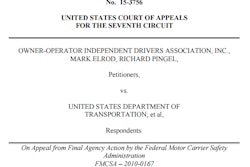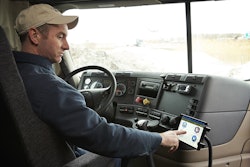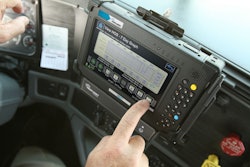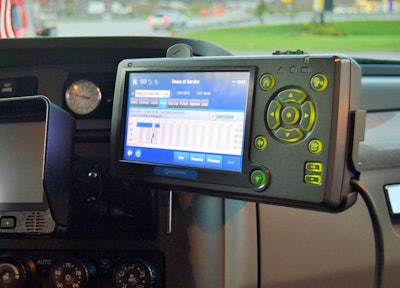 The prospect of tracking not just driver hours of service, but the location of a truck and driver, lies at the heart of a challenge to the electronic logging device mandate.
The prospect of tracking not just driver hours of service, but the location of a truck and driver, lies at the heart of a challenge to the electronic logging device mandate.The 2011 decision by a federal court to strike down the U.S. government’s previous attempt at requiring truckers to use automatic recorders to track hours of service compliance not only removed the rule from federal regulatory code. It also came with a prescription for the U.S. Department of Transportation: Ensure the devices won’t be used to harass truck operators, and get back with us.
Back the agency has come, with a fresh mandate that devotes roughly a quarter of its length to anti-harassment measures. DOT also created a corresponding rule meant to block carriers from coercing truckers to drive in violation of safety rules.
However, also back is a fresh court challenge. It’s likely to play out this year in the same court that struck down the 2012-effective mandate: the 7th Circuit Court of Appeals. It was filed by the same victorious plaintiffs: The Owner-Operator Independent Drivers Association and truckers Mark Elrod and Richard Pingel.
[gtblockquote type=”center” source=”Todd Spencer, Owner-Operator and Independent Drivers Association”]
“What’s being proposed as the standard for drivers isn’t even permissible for suspected felons without a court order.”
This time, however, the truckers and their association-backed legal challenge harp on the devices’ ability to track truckers in real time. Such personal tracking, despite being used in the course of commerce, violates truck operators’ Fourth Amendment rights to privacy, the plaintiffs claim, and does little, if anything, to promote safety.
The rule’s proponents plan to fight OOIDA’s challenge, arguing the rule intends only to track trucks and their drivers when they’re on duty and that there’s no central mechanism for monitoring drivers. Moreover, the rule’s restriction of tracking precision to a one-mile radius of the truck doesn’t constitute an encroachment of privacy, says DOT and the rule’s backers.
Duane DeBruyne, spokesperson for the Federal Motor Carrier Safety Administration, points to two provisions in the ELD rule’s final text as offering appropriate safeguards for privacy. First, 2012’s MAP-21 highway funding act “limits the way FMCSA can use ELD data,” he says, saying the federal law restricts the agency’s use solely to “the purpose of enforcing the regulation.”
Secondly, he says, when a truck operator is using a vehicle for personal use, the location tracking accuracy expands to a 10-mile radius.
Nevertheless, ELDs will be tracking nearly all drivers’ locations, says OOIDA Executive Vice President Todd Spencer. “It’s unjustified because simple hours of service compliance doesn’t require tracking of drivers,” he says. “They’ve tried to modify [the rule] a little bit to make it less intrusive, but it’s still intrusive, and it’s a violation, from what we contend. What’s being proposed as the standard for drivers isn’t even permissible for suspected felons without a court order.”
In its lawsuit, OOIDA argues the rule is a violation of protections set by the U.S. Constitution, an overreach that Spencer says “would have blown George Orwell away.”
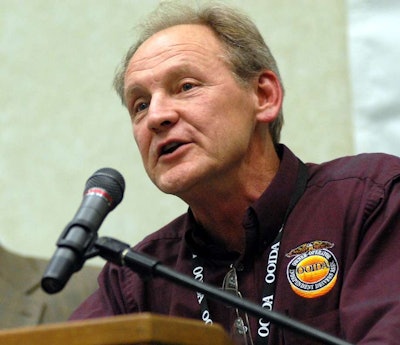 Todd Spencer, OOIDA
Todd Spencer, OOIDA“The enforcement community and others, they don’t even try to conceal their interests in having real-time exact data on drivers and trucking operations,” he says. “Whatever claims may be made, you know the overreach is going to take place, and it’s going to be done on a regular, routine basis.”
Lane Kidd, managing director for the progressive-leaning Trucking Alliance, says concerns over centralized trucker monitoring by FMCSA aren’t realistic. One main objective of the alliance, which represents some of the largest carriers, has been to push Congress and DOT to mandate ELDs.
Relative to concerns about location tracking and privacy, Kidd says the devices record location only internally, and “it’s all past tense by the time a roadside inspector or state agency auditor shows up.”
“I just don’t see how the agency is going to in any way hurt the driver’s privacy,” he says. Moreover, Kidd says, the Obama administration leans heavily pro-labor, which should quell concerns that the ELD mandate is a gift to carriers wishing to abuse the reach of the devices. “No one could look at the agency, at least the last eight years under the Obama administration, and say they were out to protect the interests of big carriers,” he says.
 Lane Kidd, Trucking Alliance
Lane Kidd, Trucking AllianceELDs could be seen as anti-harassment tools, Kidd says, because they protect truckers from being asked to work over federally prescribed hours limits. Data derived from ELDs, another privacy-focused concern by the rule’s detractors, also could strengthen both driver pay reform interests and efforts to curb unpaid detention time.
Dean Newell, vice president of safety and training at Little Rock, Ark.-based Maverick USA, says the flatbed and stepdeck fleet’s 100 or so owner-operators were skeptical when it began the transition to ELDs in 2014. Newell says the ELD rule itself and the complementary anti-coercion rule prevent carriers from intruding into drivers’ off-duty personal time.
“I think it’s fear of the unknown,” he says. “We’re all like that. If our operations guys got together and decided to take [ELDs] away from our owner-operators, we’d have a revolt on our hands” because of owner-operators’ acceptance of the devices.
Still, says Spencer, the onus is on regulators to justify a widespread mandate that some feel violates constitutional protections. “The mandate goes way beyond where any reasonable entity should have gone,” he says. “We knocked this down previously, and we’re optimistic the same result will take place this time.”
Two rules to protect drivers
As covered in some of Overdrive‘s original reporting on the final ELD rule, the mandate published in December maintained the major anti-harassment provisions included in FMCSA’s March 2014-published ELD mandate proposal.
Those include three key pieces: (1) requiring the devices to have a mute function, (2) protecting records of duty status from manipulative edits and (3) limiting location tracking.
In the weeks leading up to the rule’s December 2015 publication, the agency also published the final version of its driver coercion prohibition rule that implements large fines – up to $16,000 per incident – for carriers, shippers and brokers caught pressuring drivers to operate beyond federal safety regulations. The anti-coercion rule also puts in place a new system for truckers to file complaints of alleged coercion.
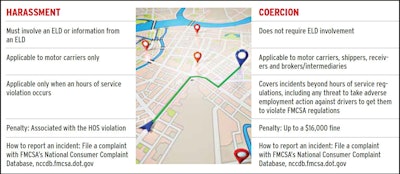
Both the ELD mandate’s anti-harassment measures and the broader anti-coercion rule protect drivers, but there are differences.
The anti-coercion rule is intended to protect truckers from “threats of economic harm” if they don’t comply with those pushing them to operate illegally. The harm could be loss of miles, loads and the like.
The anti-harassment provisions in the ELD rule must be tied to an hours of service violation. The final ELD rule defines harassment as a carrier action “involving the use of information available to the motor carrier through an ELD” or related technology “that the motor carrier knew or should have known would result in the driver violating” hours of service limits.
If no hours regulations are broken, however, FMCSA could pursue penalties against a carrier under the anti-coercion rule published in November.
The penalty assigned to a harassment instance will be based on the underlying hours violation. Harassment instances also may see intervention from the Occupational Safety and Health Administration, under the U.S. Department of Labor, which can pursue separate action against a carrier caught harassing a driver.
Here’s how the three anti-harassment measures qualify the use of ELDs:
Mute functionality: This required functionality alleviates a chief complaint that derailed the 2010 rule: Fleets using ELDs’ related functionality for messaging or alerts could interrupt drivers’ off-duty rest periods. If drivers are using a device that can make audible signals or noises, the rule requires the device to have the ability to either automatically enter a muted mode when put in a sleeper berth setting or allow a driver to turn the volume off.
Editing rights: Though the rule permits edits by drivers and carriers to be made, it also requires the devices’ original record to be maintained. It also requires all users to have a unique login so that changes can be tracked. All edits, even if made by a carrier, must be approved by a driver before being added to the record of duty status. All edits also must include an explanation.
Location tracking: The rule does not require compliant devices to track drivers or vehicles in real time. The devices are required to provide only an approximate location – within a one-mile radius – during on-duty driving periods. FMCSA says the limitation is another safeguard against harassment from carriers.
For further background on elements of OOIDA’s suit, see the following:


